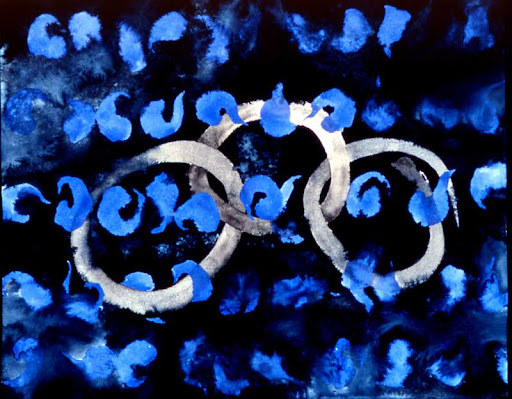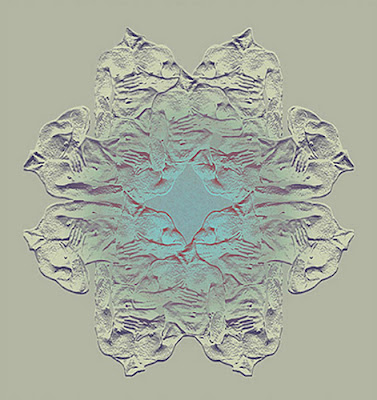
Karen Shea, Drift in the Air of Fate
Luisa A. Igloria
The Clear Bones
(inspired by Karen Shea’s watercolor painting exhibited at Courthouse Galleries, Portsmouth, VA)
Some say bone was the first kind of paper,
difficult to inscribe because it involved fractures
or accidents. Vellum and parchment came later,
then linen, canvas, reams of book paper. Lifted whole
from the dark ocean bed, a ribcage is an archive.
All the gaps between, the missing years that must be
filled in by hand: at an archaeologist’s pit or artist’s
easel; under laboratory lights or the glow cast by
a tasseled lamp over a séance table. Divination
is the art of reading the future, which is the blue
horizon dissolving like tissue in the distance,
or the level bars that make up a rune in the I Ching.
Early soothsayers threw dice made of astragali—
heel bones of hooved animals like antelope or sheep,
filed down and squared to fit the palm of the hand.
Think of the almond rattling, a little bone sheathed
in its case; a pair of plastic dice rolling onto the flocked
nap of a table, announcing their mystical numerals.
Think of the bookmaker’s baren dried from
cuttlebone, burnishing the spine that promises,
in time, to crack fully open. Mother, every day is still
a gift or curse. The bones steep in salt and water, water
and salt and air.I’ve tasted mouths and tongues and skins
of salt and yet I am no closer to divining their meaning
than the day you called the old bonesetter and her sister
to prophesy. Dressed in the colors and smells of old
tobacco, they lit candles in our living room and scared
the bejesus out of me. They flicked dry nails across
the riverbeds of my palms, crooning as if to someone
already drowned. I’d wanted to go away to the mountains
with a man nine years older, and there sketch pictures
of deer, bats lining the mummy caves, a mountain lake
hidden in blankets of fog. Perhaps I died anyway or perished
in flames I did not smell nor see burning, when I made my way.
Perhaps I floated across a river of warnings into the afterworld,
only to be returned for my desires. Everything I want is still
at least at arm’s length, a current of blue swirling with
the hint of silver. Shackle and oar, what stains the water?
Nomad, I move from one address to another, pack and carry
my worldly belongings only to unpack them in strange,
new rooms. I’m hurtled back to the beginning. Some nights
the dove of sleep lays its own head on its indigo breast
and cries for release. O Mother, the dream remains,
like window bars, like vertebrae in beveled chains.
(2007 49th Parallel Poetry Prize, Bellingham Review)
 Mom, by Jun Jun Sta. Ana
Mom, by Jun Jun Sta. AnaCesar Ruiz Aquino
Sensor
(for WPS)
What made the sound was a sun
Or moon that was nowhere in sight
And now lay under his sick bed
But the throbbing went on.
He was stranded on an island
Where dwelt a creature
Of neither night nor day
Unreal
In the bright light
Of the room.
Yet real.
Yet all this only to him.
To her it was what it was: the heart
Beating where it did not lie.
She was playing music
As it were with the sensor,
Or pressing a tattered coat,
With nothing like a memory
Of how it spooked her
Too the first time she heard it.
If that’s a gift she never had it.
If her hair now stood on end
That would be because he took it
To his head to stay the hand,
Make that Keats’ magic hand of chance
Untethered,
And press it, and press his lips to it
Which he did not.
For as far as the visible gifts went
He saw a poet's plenty stalk her
Like things she was seen to wear
Only in dreams and always
But he was frightened.
At every moment
Life hung in the balance –
She did enchant As he did feel the dread of going
The magic was in the mix
And it was his turn
To see how –
Trace the shadows
If that was granted.
Imagine her doing the work
On some stranger
Swart to her white
Chromosome for chromosome,
When the hobgoblin
Heartbeat would be hers too,
Here's to the fate
That hangs in the cadence. Imagine
The hair dropping as she comes down
Stripped to and swathed
In no seachange
To prove the music true
And the organ
Unscathed.
 Flower, by Jun Jun Sta. Ana
Flower, by Jun Jun Sta. Ana“Parcels of Horror”
“A photograph is no longer a witness, it has become part of the scene around us. Anyone can comfortably choose the parcel of horror he wishes to be moved by. You don’t agree? Don’t ever forget how far we are from those painted portraits from days past in which the human face was surrounded with a silence that rested the eyes and awakened the conscience. Now our official sympathy towards all kinds of victims frees us from responsibility. Or remorse.”
Arturo Perez-Reverte, The Painter of Battles
A young Filipino poet living far away from home, in Cape Town, South Africa, a poet and professor and an artist and photographer residing in the U.S., and a chess and literary magus from Dumaguete City in the Visayas, and images from different times. And poetry of our time. Different “parcels of horror”: inanimate steel (that is not so inanimate) nudging a corpse in Baghdad, a mural “assembling” nightly on a boulevard—alternate universes in the Paris of the Impressionists and the homeless in Manila scanning the sky for omen birds, and dreams on the sickbed. Antipodal darknesses awaiting our exploring, unlocking of keys. The key perhaps is to be intimate with horror and death, the backward dead getting in the way of machines, or the backward poverty in the way of art.
Foster-Miller [manufacturers] claims the TALON is one of the fastest robots in the market, one that can travel through sand, snow, underwater (out to depths of 100 feet) as well as climb stairs. The TALON transmits in color, black and white, infrared, and/or night vision to its operator, who may be up to 1,000 m away. It can run off lithium-ion batteries for a maximum of 7 days on standby independently before needing recharging. It has an 8.5 hour battery life at normal operating speeds, 2 standard lead batteries providing 2 hours each and 1 optional Lithium Ion providing an additional 4.5 hours. It can also withstand repeated decontamination allowing it to work for long periods of time in contaminated areas. It was used in Ground Zero after the September 11th attacks working for 45 days with many decontaminations without electronic failure…. The robot costs approximately $60,000 in its standard form. Foster-Miller were subsequently bought out by QinetiQ, a United Kingdom military developer. (Wikipedia)
Or Caillebot’s Paris on a rainy day. An early Impressionist of the Realist school, Gustav Caillebott was a rich heir who did not have to live on his paintings. After a stint in the Franco-Prussian war, he studied painting. He was a friend and supporter of many Impressionists (when the art world hadn’t yet accepted the new manner of painting), including Degas, Monet (Gustav paid for his studio rent), Renoir and Pissaro. Caillebott was greatly influenced by the new technology of photography, with his “plunging perspectives” and cropping techniques.
Eras merge and collide into each other among these paintings and images, while the poems annotate them, passing in and out of time periods and zones, in the continuing cavalcade of rogues and heroes, the faceless mass of history. It is never a pleasant experience. Art, unable to deny them, can only underline the ironies.
❜
